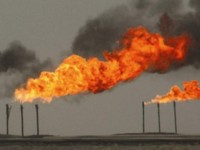Despite the gigantic numbers, there’s good news, as eliminating
wasteful gas flaring could be the next big energy and environmental
success story based on technologies that exist today. For example,
among the tech solutions is capturing the gas and using it for
power generation or re-injecting it into the ground to help with
oil recovery efforts.
GE’s study finds that nearly $20 billion in wasted natural gas
could be used to generate reliable, affordable electricity and
yield billions of dollars per year in increased global economic
output.

In action:
target=”_blank”>In the first large-scale application of its
type, advanced compressor technology from GE Oil &
Gas will be minimizing liquefied natural gas (LNG)
flaring in Qatar.
The gas that usually boils off during the loading of LNG
carriers at port will now be collected and transferred to a central
compression area via pipelines and then used to fuel the
refrigeration plants that liquefy the gas for export.
As gas is often present when drilling for oil, gas flaring has
been part of the oil industry since its inception. With much work
having been done over the last decade, large scale flaring is rare
at new drilling projects.
However, some of the largest waste gas streams occur in remote
areas where lack of a market, lack of pipeline access, and/or small
volumes do not justify the expense of gas gathering.
“With greater global attention and concerted effort- including
partnerships, sound policy and innovative technologies -
large-scale gas flaring could be largely eliminated in as little as
five years. It’s a win-win outcome,” said Michael Farina, program
manager at GE Energy and author of the white paper.
For example, as
target=”_blank”>The Financial Times noted in its
story, “if Russia could capture half its flared gas and
sell it at domestic market prices, it would be worth an extra $2bn
a year.” Farina told the paper that “there were many countries,
such as Norway, Indonesia and Angola, that provided good examples
of how to cut flaring.”
The next step involves a coordinated effort from central and
regional governments, oil and gas producers, technology providers
and the international community.
The goal is to highlight the financial benefits associated with
reducing gas flaring; secure local government support for
monitoring and enforcing flaring regulations; and build capacity
that helps local investors and contractors develop, operate and
service distributed power generation.
The report provides a region-by-region analysis of gas flaring
trends. In the case of Nigeria, it has reduced flare gas emissions
by 28 percent from 2000 levels. Even so, the country’s oil industry
still wastes 15 billion cubic meters of natural gas every year.
While nearly half of the population has no access to electricity,
the country spends nearly $13 billion per year on diesel-powered
generation and perhaps 10GW of potential electricity is flared
away.
* A PDF copy of the report, Flare Gas Reduction: Recent Global
Trends and Policy Considerations, is available by
target=”_blank”>clicking here

 In a time when energy is scarce,
In a time when energy is scarce,